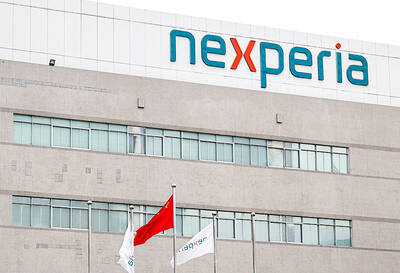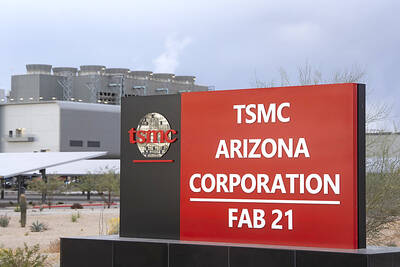Largan Precision Co (大立光), a major smartphone camera lens supplier to Apple Inc, might face limited earnings growth this year given the industry’s slow transition to higher-resolution lenses, Yuanta Securities Investment Consulting Co (元大投顧) Taipei-based analyst Jeff Pu (蒲得宇) said.
“With limited earnings upside and high market expectations, we continue to suggest investors take profit on the stock,” Pu wrote in a note to clients on Thursday last week.
Largan reported sales of NT$4 billion (US$127 million) for last month, up 66 percent year-on-year, but down 30 percent from December last year, falling below market expectations of a 20 percent decline month-on-month.
Pu said that Largan’s sales for last month came in below expectations due to lower demand for Apple iPhones, a smaller proportion of iPhone 6 Plus models in Largan’s shipment mix and weak demand from Chinese handset brands.
“February will be affected by fewer working days, and we don’t expect much of a recovery in March owing to the fast-falling number of iPhone [shipments],” said Pu, who maintained his “downgrade” rating on Largan shares and his price target of NT$2,650 for the stock.
Pu said that the camera specifications of the next-generation iPhone, dubbed iPhone 6S, will stay the same as the current iPhone 6 at 8-megapixels, limiting potential catalysts to push Largan’s stock price higher in the second half of the year.
Pu said that although the migration to 8-megapixel and 13-megapixel lenses would remain strong among Chinese vendors of mid-tier and low-end phones, upgrades to 16-megapixel and 20-megapixel lenses for flagship phones would be slow given the limited supply of CMOS sensors — used to convert light into electrons.
“On the other hand, we expect the specification migration in high-end models to be from new features, such as optical image stabilization and fast autofocus, which benefit module makers more than lens makers, in our view,” Pu said.
Data from Japanese research firm Techno Systems Research Co showed that Japan-based Sony Corp led the 2013 global CMOS image sensor market with a 33 percent share by sales value.
Sony, whose CMOS sensors are used in handsets made by Apple, Samsung Electronics Co Ltd and Huawei Technologies Co Ltd (華為), announced on Monday last week that it plans to increase its production capacity for stacked CMOS image sensors from its current level of about 60,000 wafers per month to about 80,000 wafers per month by the end of June next year.

JITTERS: Nexperia has a 20 percent market share for chips powering simpler features such as window controls, and changing supply chains could take years European carmakers are looking into ways to scratch components made with parts from China, spooked by deepening geopolitical spats playing out through chipmaker Nexperia BV and Beijing’s export controls on rare earths. To protect operations from trade ructions, several automakers are pushing major suppliers to find permanent alternatives to Chinese semiconductors, people familiar with the matter said. The industry is considering broader changes to its supply chain to adapt to shifting geopolitics, Europe’s main suppliers lobby CLEPA head Matthias Zink said. “We had some indications already — questions like: ‘How can you supply me without this dependency on China?’” Zink, who also

At least US$50 million for the freedom of an Emirati sheikh: That is the king’s ransom paid two weeks ago to militants linked to al-Qaeda who are pushing to topple the Malian government and impose Islamic law. Alongside a crippling fuel blockade, the Group for the Support of Islam and Muslims (JNIM) has made kidnapping wealthy foreigners for a ransom a pillar of its strategy of “economic jihad.” Its goal: Oust the junta, which has struggled to contain Mali’s decade-long insurgency since taking power following back-to-back coups in 2020 and 2021, by scaring away investors and paralyzing the west African country’s economy.

Taiwan Semiconductor Manufacturing Co (TSMC, 台積電) received about NT$147 billion (US$4.71 billion) in subsidies from the US, Japanese, German and Chinese governments over the past two years for its global expansion. Financial data compiled by the world’s largest contract chipmaker showed the company secured NT$4.77 billion in subsidies from the governments in the third quarter, bringing the total for the first three quarters of the year to about NT$71.9 billion. Along with the NT$75.16 billion in financial aid TSMC received last year, the chipmaker obtained NT$147 billion in subsidies in almost two years, the data showed. The subsidies received by its subsidiaries —

BUST FEARS: While a KMT legislator asked if an AI bubble could affect Taiwan, the DGBAS minister said the sector appears on track to continue growing The local property market has cooled down moderately following a series of credit control measures designed to contain speculation, the central bank said yesterday, while remaining tight-lipped about potential rule relaxations. Lawmakers in a meeting of the legislature’s Finance Committee voiced concerns to central bank officials that the credit control measures have adversely affected the government’s tax income and small and medium-sized property developers, with limited positive effects. Housing prices have been climbing since 2016, even when the central bank imposed its first set of control measures in 2020, Chinese Nationalist Party (KMT) Legislator Lo Ting-wei (羅廷瑋) said. “Since the second half of